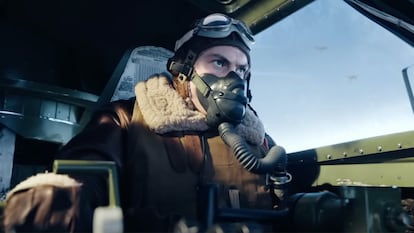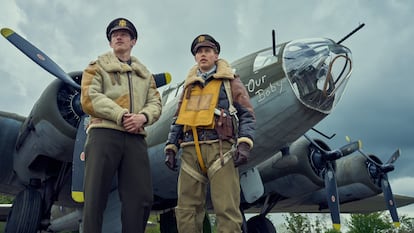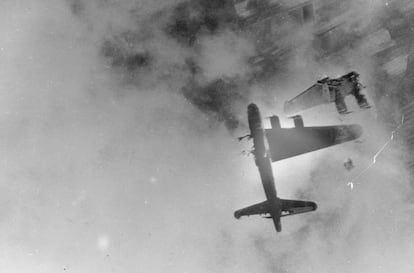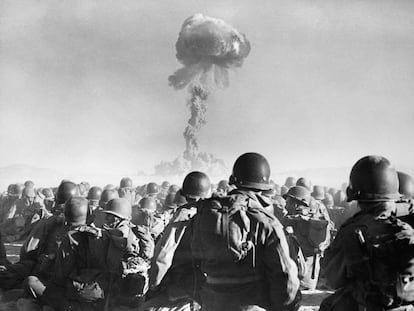The horror of fighting in a Flying Fortress: ‘Masters of the Air’ shows aerial warfare as it has never been seen before
The magnificent series, in the wake of ‘Band of Brothers’ and ‘The Pacific’, reconstructs the daring World War II American B-17 bomber missions with shocking realism


Swarms of German fighters tear through American bomber formations like deadly bolts of lightning in a sky streaked with condensation trails and the murderous glare of tracer fire. A furious, desperate combat takes place on an infinite battlefield in the sky above. B-17s are shot down, plunging towards the ground or spinning around like the burning leaves of giant trees. The pilots of the Flying Fortresses try to maintain formation so as not to become solitary prey for enemy fighters. And in the midst of the storm of destruction, the gunner in the exposed ball turret on the plane’s underbelly explodes in a cloud of blood when hit.
“Superb,” said the British James Holland, one of the fashionable military historians, of the new World War II miniseries Masters of the Air. Of course, stories of air combat have been told before, but never the war waged by the American heavy bombers over Germany and occupied Europe, and certainly not with the realism and emotion with which it appears in this nine-episode Apple TV+ miniseries. Masters of the Air is very faithfully based on the extraordinary 2006 book by Donald L. Miller of the same title.
With the same successful formula as Band of Brothers (parachute regiment) and The Pacific (marines) and Tom Hank, Steven Spielberg and Gary Goetzman as producers, Masters of the Air follows an American unit’s campaigns throughout World War II. This time the story focuses on the members (pilots, crews, mechanics, and commanders) of the “Bloody 100th,″ a long-suffering Bombardment Group in the famous US Eighth Air Force, stationed in eastern England. From their base in the English countryside the famous Flying Fortresses — impressive four-engine Boeing B-17 heavy bombers — took off pregnant with a devastation they intended to make rain down to subdue Nazi Germany.

Throughout the series we witness sensational, bone-chilling scenes, our hearts in our mouths and amazed at what human beings are capable of suffering (and inflicting) in war. In one scene Messerschmitt Bf 109s attack the bombers from the front, spraying them with bullets that open large holes in the cabin, in the fuselage and in the flesh of the American aviators. In another we see the little puffs of black smoke that comes from the Flak (the German anti-aircraft defense). The projectiles dot the sky and shake the bombers when they detonate — so much for modern-day turbulence — these little explosions can literally burst the planes and their crews wide open.
At one point, the crew of a B-17 debris from other disintegrated bombers rain down, including a body that hits their wing. Other shocking scenes are the one in which a crew member gets caught in the bomb hatch while trying to parachute out of his plane while it plunges into a dizzying fall and a comrade tries desperately to free him, or when a returning crew member falls to his knees and vomits violently as he tries to comprehend the slaughter he witnessed on an failed mission.
The series shows very well the contrast between the powerful bombers, which were marvels of aeronautical technology at the time and that take off in impressive formations, and the way in which they are destroyed. As one pilot summarized when trying to assimilate the vision of ten men and three tons of metal reduced to a cloud of black smoke, “it seems impossible that something so big could disappear so quickly.” In the scene featuring a forced landing of a bullet-riddled B-17, with two engines out of action, no wheels, and several crew members dead or badly injured, it is impossible not to shudder when the pilot utters the phrase: “Crew, prepare for landing.”

Most of those scenes come from the book, and from real testimonies collected by Miller. The most incredible thing about the series is that in reality it truly was like that. And after surviving bloody and terrifying missions, those young people from the four corners of the United States and from all social classes were able to get back in their planes the next day. 26,000 airmen of the 8th Air Force died. They suffered more fatalities than the Marine Corps. Masters of the Air shows definitively that if there was anything worse than serving in submarines during World War II, it was serving in the bombers.
To the soldier’s usual fear of death, being part of a bomber crew added vertigo and claustrophobia — the planes look big on the asphalt, but they are laden with bombs and space on board is tight. Not only that, the environment at 10,000 feet is extremely hostile. The lack of oxygen and the cold, along with the atmospheric conditions, were among the mortal dangers that the aviators faced, and the series shows this very well. In one episode, we see how a machine gunner who removes his gloves to unjam his weapon gets his hands stuck-frozen to the metal and tears his skin off as he frees himself.
The group’s adventures are especially well represented — as in Miller’s book — through a set of real characters, played by actors, such as Majors Gale Buck Cleven (Austin Butler) and John Bucky Egan (Callum Turner), Lieutenants Harry Crosby (Anthony Boyle), Glenn Graham (Darragh Cowley), and Curtis Biddick (Barry Keoghan, the in vogue star of Saltburn), and ground Sergeant Ken Lemmons, played by Rafferty Law, son of Jude Law.
The proven formula of telling a story from within a combat unit and emphasizing the human dimension of its members reworks its magic in Masters of the Air (we inevitably suffer for those young people in life and death situations in their planes. It awakens our affinity for them and we identify with young airmen, at a time when it is extremely difficult to do so with the military who sow chaos and destruction and devastate cities, killing the civilian population with their bombs.

And if there is any weapon that is difficult to empathize with, it is bombers. The debate over the horrific destruction caused by American high-altitude strategic bombing in World War II appears in Miller’s book and in the series, in which some airmen question the slaughter of civilians. In any case, both the series and the book opt for the reassuring thesis that this suffering was necessary to put an end to the Nazis, and that somehow the Germans had asked for it.
Miller tries to distinguish between the American bombing, which would always have been targeted, he emphasizes, at attacking the German war effort (even considering that the bombs go off course) and that of the British, who did not hesitate to destroy cities deliberately. The series and book continually remember the enormous sacrifice made by the bomber crews, who lost 60 Flying Fortresses and almost 600 men in a single mission. Another complex issue that the book and series mention is that of racism: the democratic United States allowed some Black pilots to fly fighter planes (the Tuskegee men) but in no way in bombers.

What stands out about the series is its technical and operational accuracy (the missions it recounts are authentic, including the one that ended with the landing in North Africa after bombing Regensburg) and a production design that takes meticulous care of everything, from the planes to the smallest period element, passing through the aviators’ clothing, with the iconic leather and sheepskin jackets.
There are also the many historically accurate details. Among them, the secrecy with the Norden sights, the decisive instrument that allowed American bombers to hit the targets with unprecedented precision, or the scene in which a radio operator eats the sheets with the frequencies and the secret identification of the device before it can fall into enemy hands. Likewise, the way in which the atmosphere in the bases (and the canteens) is shown, the crew members’ superstitions, the stress of combat, the fear (“the Focke-Wulf funk”), the mystique of the 25 missions after which you were going home (the true story of the B-17 Memphis Belle, which the 1990 film of the same name focused on), the positive relationship of American personnel with British children, and the romantic and sexual relationships during the war.
Through parallel plots, the series very accurately captures how the escape networks worked for downed pilots (through them Chuck Yeager was able to return to combat), and the lives of the captured airmen and interned in concentration camps (Stalag Luft, like the one in The Great Escape).
Among the drawbacks, the accentuated — and sometimes excessive — epic sense of the narrative, and a certain aestheticism (it is doubtful that the “bomber boys” were all so handsome and posed so well). These are two things that certainly contribute to making Masters of the Air a great spectacle, but that jar a little with the ultimate reality of how the bombers left the world below after they had delivered their payloads.
Sign up for our weekly newsletter to get more English-language news coverage from EL PAÍS USA Edition
Tu suscripción se está usando en otro dispositivo
¿Quieres añadir otro usuario a tu suscripción?
Si continúas leyendo en este dispositivo, no se podrá leer en el otro.
FlechaTu suscripción se está usando en otro dispositivo y solo puedes acceder a EL PAÍS desde un dispositivo a la vez.
Si quieres compartir tu cuenta, cambia tu suscripción a la modalidad Premium, así podrás añadir otro usuario. Cada uno accederá con su propia cuenta de email, lo que os permitirá personalizar vuestra experiencia en EL PAÍS.
¿Tienes una suscripción de empresa? Accede aquí para contratar más cuentas.
En el caso de no saber quién está usando tu cuenta, te recomendamos cambiar tu contraseña aquí.
Si decides continuar compartiendo tu cuenta, este mensaje se mostrará en tu dispositivo y en el de la otra persona que está usando tu cuenta de forma indefinida, afectando a tu experiencia de lectura. Puedes consultar aquí los términos y condiciones de la suscripción digital.
More information
Archived In
Últimas noticias
Welcome to the post-religion era: The idea of Christianity as the absolute truth has become obsolete
‘I thought you would like it’: The risky sexual practice popularized by TV shows and TikTok
The digitalization of tourism: ‘They promise experiences and gave us the worst possible one’
Mexican peso defies uncertainty with forecasts of a new period of stability in 2026
Most viewed
- Sinaloa Cartel war is taking its toll on Los Chapitos
- Oona Chaplin: ‘I told James Cameron that I was living in a treehouse and starting a permaculture project with a friend’
- Reinhard Genzel, Nobel laureate in physics: ‘One-minute videos will never give you the truth’
- Why the price of coffee has skyrocketed: from Brazilian plantations to specialty coffee houses
- Silver prices are going crazy: This is what’s fueling the rally










































